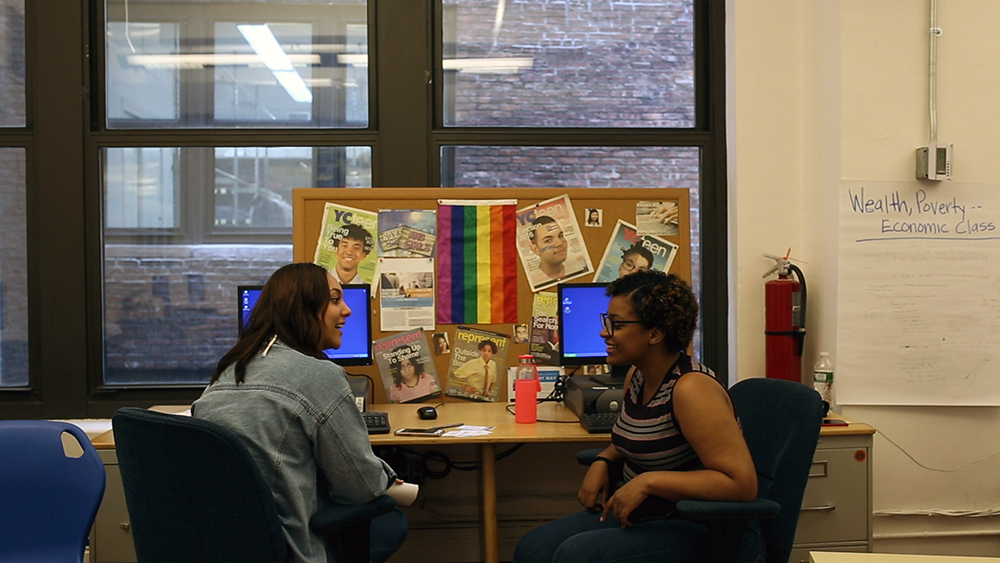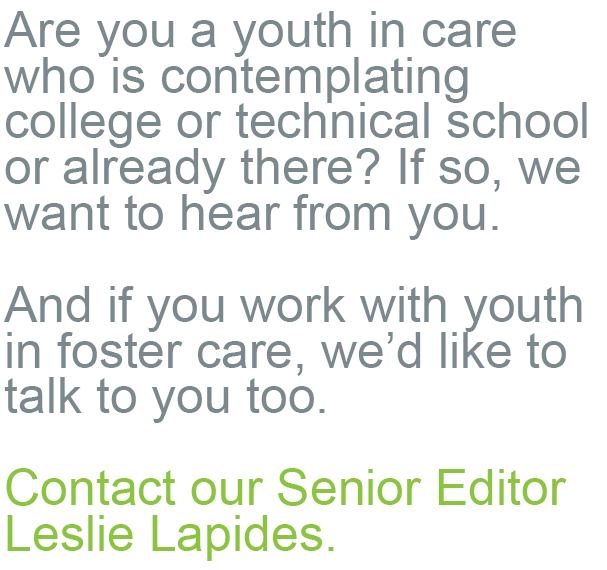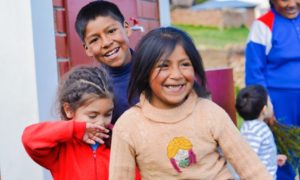Video by Roger Newton
Early on, many youth in foster care develop a certain resourcefulness that allows them to navigate thorny situations and push through layers of bureaucracy.
But almost inevitably, youth in care struggle as they leave high school, enroll in community college, trade school or university and make their way toward graduation.
“These foster kids are brilliant and resilient, but they’re not getting the support they need,” said Michelle Francois Traiman, who heads up the Foster Youth Education Initiative at the National Center for Youth Law in Oakland, Calif.
At nearly every step of that journey, the data is bleak — and often so poorly tracked that exact numbers are elusive. It’s likely that only 50 percent of such youth complete high school by age 18, according to a summary of foster-care education research published by the National Working Group on Foster Care and Education. Estimates of what proportion finish college with a bachelor’s degree range wildly, from 1 to 11 percent, because the tracking of students in foster care in higher education has been inconsistent and, in some cases, nonexistent.

Debbie Raucher
Still, even the high end of that estimated graduation range, 11 percent, is tragically low when compared with graduation rates in the general population, which are nearly 30 percent.
It’s not that foster children don’t have collegiate ambitions, said Debbie Raucher, who leads the California College Pathways Initiative. “Getting into college is one thing. Being successful is another,” she said, noting that a fair number of foster youth enroll in California colleges, though few graduate.
Mobility hurts success
Melody McLaurin, 20, a student at Kennesaw State University in Kennesaw, Ga., found the transition from high school to college extremely stressful. “When I was 18, I had to make all these adult decisions and I really didn’t feel prepared for it,” said McLaurin, who calls that period of time “my all-time low.” McLaurin is attending college with the help of the Educational Training Voucher (ETV) program, part of the John H. Chafee Foster Care Independence Program, which helps current and former foster students pay for college, training or career school.
Meanwhile, her younger sister, Chelea McLaurin, 17, found a good fit at her third foster home. But as a result, she was transferred to a high school that was much less competitive and didn’t offer as many Advanced Placement and honors classes.
Mobility for students like Chelea can undermine success. So, to understand the bigger picture for her and the nearly 270,000 K-12-aged students in foster care, the federal Every Student Succeeds Act (ESSA) in 2015 required state education departments to share data about K-12 academic outcomes with child welfare agencies. Implementation is still spotty in some places.
Congress also tried to increase school stability for foster students by requiring they not automatically change schools whenever they change foster care placements. Instead, schools must follow a policy that’s long been in place for homeless students: The originating school must pay to transport the students each day, with help from the local child welfare agency, if necessary.
That doesn’t seem to be followed in all cases. Chelea McLaurin, for instance, found a better foster care placement but when she moved, she ended up transferring to less competitive high school that offered fewer advanced classes. Sometimes, it’s just too hard to stay in the same place: the bus rides can be too long or students involved with extracurriculars may have problems getting home afterward.
And that can create new challenges. Gianni Cuevas, 20, a student at LaGuardia Community College in Queens, recalls how he stayed in the same Bronx high school until he graduated. But because he was shifting placements, he sometimes traveled up to two hours in the morning, making him late to class. And after a certain number of absences, his school failed him, even though he was doing his coursework. That contributed to his feeling that he was on his own.
“I view myself as a lone wolf,” Cuevas said. “You can be around people and still feel very much alone. That was me, growing up.”
What we’re doing and why
Over the next 12 months, Youth Today reporters will examine what is working and why, from complex data-sharing systems at the high school and college level to the most rudimentary solutions, like mandated contact between the agencies linked to each student.
We’ll look at the role of full-ride scholarships, year-round housing and on-campus life coaches in helping to increase college graduation rates. We’ll also look at ways that colleges are able to ensure that former foster students are stably housed when the dorms close.
Sky Ross, 25, remembers how that felt as she attended UCLA. “Whenever there’s a break or a holiday, everyone looking forward to spring break, summer vacation, and Christmas — ‘Oh, I can’t wait to see my family.’ But you might not have a family you want to see,” she said.

Clarissa Sosin
Anastasia De La Mota (left), 19, and Chantel Jackson, 19, are both attending community college in New York City while in the foster care system. They were taking a writing workshop at the offices of Represent Magazine in New York City.
Until a decade ago, most youth in care aged out of the system at 18, making college an experience that foster care systems didn’t often grapple with. Instead, systems focused on more stable homes and child safety rather than moving a youth in care toward college and independence.
In addition, such young people’s academic struggles and experiences with substance use, trauma and involvement in the juvenile justice system often throw up barriers that can make college applications and campus life daunting.
Over the past decade or so, foster care has been extended until age 21 in at least 25 states and the District of Columbia, thanks partly to an extension of federal reimbursable foster care money from the Fostering Connections to Success and Increasing Adoptions Act of 2008, according to the National Conference of State Legislatures.
What will progress look like?
The move to extend foster care beyond age 18 stemmed partly from a telling 2002 analysis out of the University of Chicago’s Chapin Hall that compared Wisconsin and Iowa, where foster care ended at 18, with Illinois, where youth have long been allowed to extend care to age 21. Youth in Illinois who were formerly in foster care were twice as likely to have attended college at all by 21 as youth in Wisconsin and Iowa, and twice as likely to have completed a full year of college.

Nat'l. Center for Youth Law
Michelle Francois Traiman
Some states have invested time and resources into data systems that track youth in care at every grade of public school and through college. Others are hiring liaisons who interact with overburdened teachers and social workers to help create learning networks.
Still, good intentions and digital bells and whistles mean little unless enrollment and graduate rates rise, Traiman, of the National Center for Youth Law warns. “Until we’re talking to teachers and students and seeing outcomes change, it’s not progress,” she said.
For the Youth Today stories, we will report from different regions, relying on foster youth to tell us what works and what they need to further succeed. Foster youth will help us focus this series and tell us what works. We want to understand where youth in care are making strides in education — and we’ll tell the stories through the lens of young people themselves, who will help us focus this series on what really matters.
[Video: What’s Working (and Not) for Youth in Foster Care Who Enter Higher Education]




























